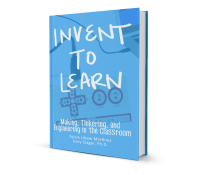 So some of you may have noticed that I’ve been pretty quiet here lately. All my writing energy has been going to a good cause though! I’m happy to announce a new book: Invent To Learn: Making, Tinkering, and Engineering in the Classroom, authored jointly by yours truly, Sylvia Martinez, and Gary Stager.
So some of you may have noticed that I’ve been pretty quiet here lately. All my writing energy has been going to a good cause though! I’m happy to announce a new book: Invent To Learn: Making, Tinkering, and Engineering in the Classroom, authored jointly by yours truly, Sylvia Martinez, and Gary Stager.
This book has been cooking a long time, fueled by our belief that many schools are heading away from what real learning looks like – projects that are student-centered, hands-on, and authentic. But there is a technology revolution out there that has the potential to change that. New materials and technology can be game-changers: things like 3D printing, microcomputers like Raspberry Pi and Arduino, sensors and interfaces that connect the physical world to the digital, and programming. At the same time, a vibrant “maker movement” is spreading worldwide, encouraging people to make, tinker, and share technology and craft.
Invent To Learn is for educators who want to learn about these new technologies and how they can work in real classrooms. But it’s not just about “stuff” – we explore teaching, learning, and how to shape the learning environment. By combining the maker ethos with what we know about how children really learn, we can create classrooms that are alive with creativity and “objects to think with” that will permanently change education.
Student leadership
One chapter of Invent To Learn is about how learning by doing also gives students a chance to become leaders in their schools and communities. Giving students access to modern creativity tools and technology is not about “jobs of the future,” it’s about real learning NOW.
Making for every classroom budget
Even if you don’t have access to expensive (but increasingly affordable) hardware, every classroom can become a makerspace where kids and teachers learn together through direct experience with an assortment of high and low-tech materials. The potential range, breadth, power, complexity and beauty of projects has never been greater thanks to the amazing new tools, materials, ingenuity and playfulness you will encounter in this book.
Check the Invent To Learn website for information on getting the print or Kindle version of the book, and also about professional development for your district.







 I keynoted the
I keynoted the  From
From 